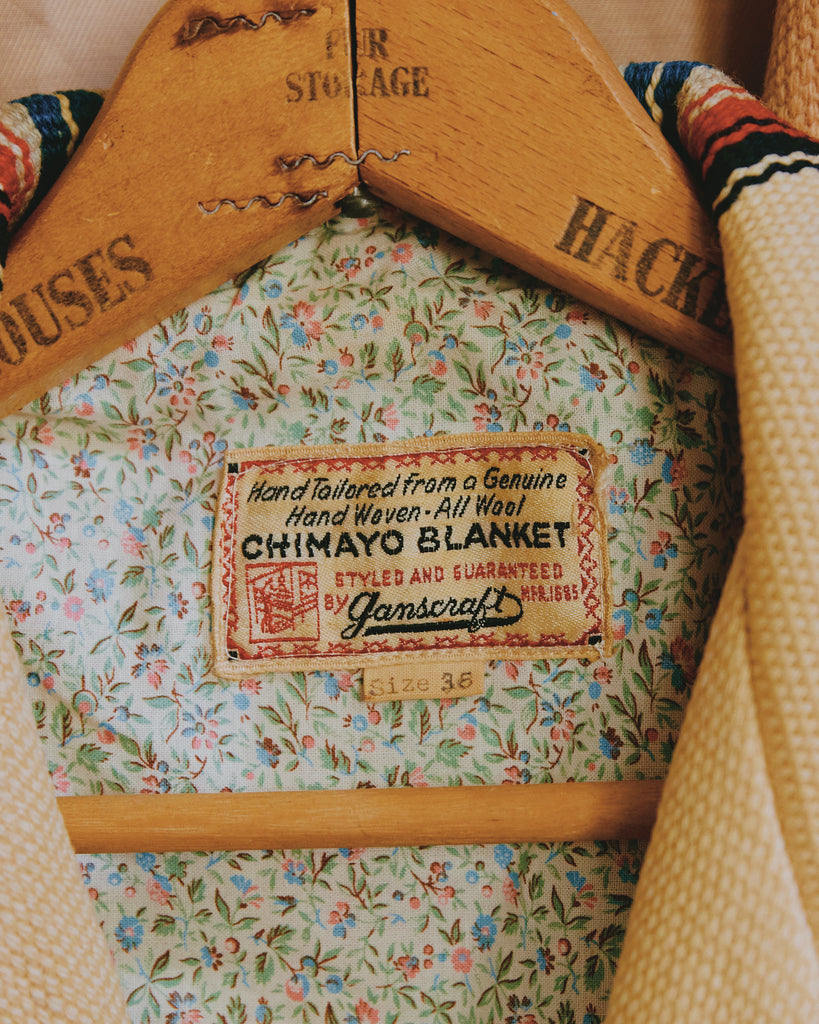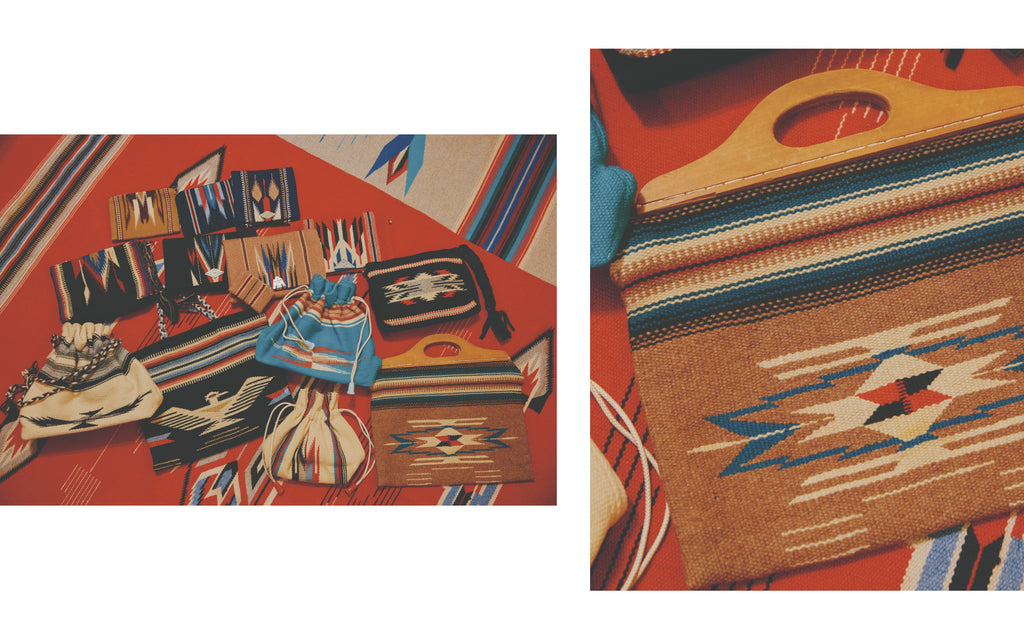
The screen lights up to reveal an extreme closeup of Satoshi Suzuki’s nose and eyes. We laugh and he does too as he readjusts the frame to include a quarter of himself, a column of eye-catching Chimayo clothing hanging on the door behind him, and half of his wife, Fumi.
Shinya has always been the “youngster” in the friend group he shares with Satoshi, but now everybody is getting up there in years, and 10 years doesn’t seem like such a big gap anymore. We realize suddenly that although we’re laughing at Satoshi for not being in the frame of the camera, we are actually not in ours either. We all adjust ourselves to greet each other and catch up.
You can read the story about how Satoshi and Shinya became friends here, but the short version is that Shinya saw Satoshi outside of his curio shop in NOLITA and struck up a conversation. Satoshi hired Shinya, vetted him, introduced him to his friends group including Daiki and Takeshi, and helped Shinya gain entrance to the wonderful world of making clothes in Manhattan’s garment district. It wasn’t that quick or quite so A to Z, but you get the gist. He’s an important person to us. (Beyond being the man behind Otakara and our Otakara x Battenwear collab)

We’ve been trying to schedule this facetime with the Suzukis for ages now, so it feels nothing short of a miracle that we’re all sitting here together finally, mostly in the frame.
Earlier in the fall, we had asked Satoshi to share something he collects with Battenwear journal readers ( à la Shuhei and his synthesizers, etc). He wrote back to say that he and Fumi wanted to chat with us about their Chimayo collection.
Satoshi and his wife are some of the most impressive and extensive general collectors that we know, and one of the things we appreciate most about them is that they use everything they collect. Which is to say, they are not collectors of pristine things to be kept in museum quality. They are finders, fixers, and standard bearers of well-loved, rare treasures.
If you find yourself at a party with one of them, please ask about something they are wearing. A ring or shirt or bag that catches your eye–you’ll be in for a story about how they traded it for some other wonderful thing at a tiny place in the middle of nowhere America from a woman who told them her life story . . . It’s a remarkable talent, being able to spot gems in what just seems like normal, everyday things to everyone else. But that’s what the Suzukis do, whether it’s clothing, jewelry, art, people.
It’s important to note that they live in a cozy Manhattan highrise apartment that is already filled with the best of the best from Satoshi’s younger years of treasure hunting by Greyhound bus all over rural America, so actually, there’s no room to add things that don’t have purpose/use in their everyday life. Although, if you are wondering with some trepidation what the inside of a small NYC apartment filled with so many treasures must look like, we can’t attest that it’s actually extremely well organized. Like a particularly tidy, particularly fascinating vintage shop.

Anyhow, of all of the many many types of wonderful things that the Suzukis collect, why was it their Chimayo collection that they wanted to share with us? We were excited to find out!
BATTENWEAR: So, when did you guys start collecting Chimayo items?
SATOSHI: I started in the 1980’s. Everyone I knew who collected vintage items had a few Chimayo pieces, but I didn’t know anyone who had a significant collection. My mentor taught me what I needed to know about Chimayo, and I thought it would be fun to collect. Honestly, Chimayo is not something that most people can wear everyday, but it really suits Fumi and me.
From the start, I bought everything I could find, regardless of size or condition. I repaired what I bought, replacing the lining of jackets, etc, adding extra pockets and details.

If I don’t want to keep any particular item for our own use, I knew I could use it to trade. Fumi actually has a better Chimayo collection than I do. I only have 3 perfect condition items in my size, but there is much more available in smaller sizes like Fumi’s. I recently traded some of my more valuable Chimayo pieces that I knew we couldn’t wear so that I could get a Chimayo coat for Fumi.
FUMI: I started collecting in the 1990’s while Satoshi was working at a vintage store in Tokyo. That’s when I got really interested. Collecting feels like treasure hunting. Of course most of the time, it is very boring and dull but when you find something you want, it’s very exciting.

BATTENWEAR: So, collecting Chimayo is kind of part of your relationship. That’s really sweet.
FUMI & SATOSHI: (Laughing at us) Really? C’mon.
BATTENWEAR: Alright, fine. No sappy stuff. How can you tell if a particular Chimayo item is valuable?
SATOSHI: After a while, you start knowing what to look for. I’m very picky when it comes to colors and patterns. There are lots of very common Chimayo themes with light, natural base colors. I look for the darker colors which are more rare, as well as the older pieces that have more complicated patterns and motifs. Actually, one of the patterns I look for the most might seem controversial to some people because it has the symbol which was stolen from tribal cultures and turned into the German swastika. I think it’s really important to reclaim the original meaning of the symbol.
FUMI: We also look for items that we know are more rare, like short jackets, or items with more complex motifs like eagles, arrows, and baskets.

BATTENWEAR: What about the manufacturers of the Chimayo items? Do you look for particular brands or labels?
SATOSHI: In the early part of the 20th century until the 1960s, there were many different manufacturers of Chimayo in the southwest, especially New Mexico. The Chimayo craft originated in Mexico but became commercially popular in the southwest. There were lots of limited time manufacturers of Chimayo, and they sold to tourist shops and outposts. Sort of like how you see Hawaiian shirts in airports now. Some of my favorite pieces from over the years have been from the manufacturers Ortega, La Axteca, El Grandee, Fred Harvey etc.
BATTENWEAR: You started collecting in the 1980s & 90s and are still collecting today. How has the process of collecting changed over the years?
FUMI: Satoshi doesn’t drive, so when he used to do his buying trips, he took buses, planes, and trains. Every month, he would visit antique and thrift shops in places like Baltimore, Chicago, and St. Louis. As time went on, we started going to antique markets in NYC, because it was more convenient. We would have to get to the venues in the early morning to get the best items. But gradually we started seeing fewer and fewer vintage dealers in the city. Now we mostly shop online.
SATOSHI: I have over 400 items on my EBAY watch list on any given day.
BATTENWEAR: That must be overwhelming. Um, so Shinya just left to pick up the kids from school. While he’s gone, can you give us any embarrassing stories from when you guys first met?
SATOSHI: My first impression of him was positive. He knew how to act around older people and I was comfortable introducing him to my friends. It was a big test to see how he would work with Daiki on the Woolrich Woolen Mills project. I remember one time at the start, he got to the airport to take the collection to Milan for Pitti Uomo, and he realized that his passport had expired. All us older guys were all out that night when we heard what happened, and we agreed that the way Shinya handled it would decide if he went on to do great things or crash and burn. We’re really glad he didn’t crash and burn!
BATTENWAR: Yet!
SATOSHI & FUMI: (laughing) Yet!
BATTENWEAR: Thank you for sharing all of this with us!

